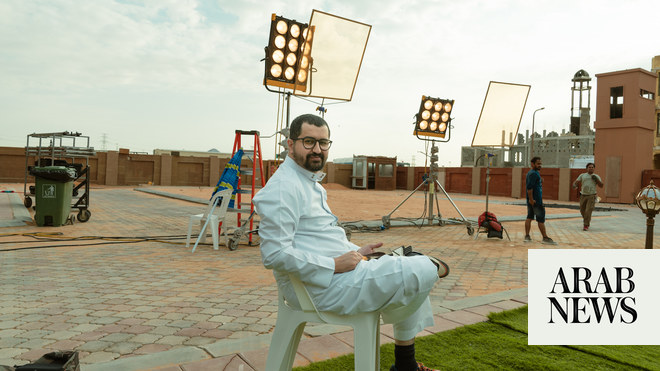
DUBAI: Musa Hadid, the mayor of Ramallah in Palestine’s West Bank, never imagined that he was documentary material. After all, the life of a bureaucrat who spends his day in meetings devoted to branding and traffic signals is not the sort of figure who normally captures the attention of an American filmmaker. For director David Osit, that was exactly why he chose Hadid as the subject for his latest film, “Mayor.”
For the latest updates, follow us on Instagram @arabnews.lifestyle
“Watching the news in America, you see no diversity or complexity in the depiction of Palestinians, (nor) really of the entire Middle East. You either see depictions of terrorists, or you see victims, but in that depiction, they"re all so one-dimensional. They"re lacking agency,” Osit tells Arab News.
Hadid is a very different sort of figure. He is, at his heart, a public servant, one who is focused on the power of local government to make small but transformative changes to people’s lives. It’s a job that is, by and large, mundane. There are Musa Hadids in every city on earth. The difference for Hadid, of course, is that he’s also trying to keep his city functioning in occupied territory — a job that is often equal parts rewarding, farcical, and heart-breaking.
Musa Hadid is the subject for Osit’s latest film, “Mayor.” (Supplied)
It was the universal aspects of Hadid’s job that Osit believed would allow audiences to connect with the story, while also bringing the differences between Hadid and the mayors of their own cities — and thus the average Palestinian’s situation — into stark relief.
“I felt from the start that it would be a story that Westerners, especially Americans, would be able to engage with in a way that didn"t put their guard up, or didn"t make them feel like they were uneducated, and instead gave them this really common framework to understand some elements of the situation,” says Osit.“I really wanted to make a film that didn"t require people to basically have a history degree. It"s unfair to expect everyone to be able to understand all the complexities that are part of this world, so I asked what I could do, with my education and understanding (Osit is a graduate of the Center for Middle Eastern and North African Studies at the University of Michigan), to actually simplify things for somebody else.”
The idea to profile Hadid came when Osit returned to Ramallah to find a city unrecognizable from the one he’d visited years earlier, when he spent time in the region assisting on films and studying refugee law at the University of Cairo.
Osit travelled in and out of Ramallah for three weeks at a time over a period of two years while making “The Mayor.” (Supplied)
“It seemed like, all of a sudden, there were hipster spots and nightclubs,” he says. “There"s free unlimited public Wi-Fi and a Jaguar dealership. There’s Popeye’s! All these things were very interesting, and a little odd. There are monolithic expectations of what a ‘Middle Eastern city’ should look like. And Ramallah really stood out against that monolith.”
Osit travelled in and out of Ramallah for three weeks at a time over a period of two years while making “The Mayor.” He decided against moving to the city full time to shoot the film because he wanted to embrace the benefit that an outsider perspective gave him on the city and the situation, a clarity of vision that can get lost when one is fully embedded in it.
What’s more, he felt that positioning himself as anything but a foreigner who lacks the lived experience of a Palestinian, even to a small degree, would have been dishonest.
“It would be absurd of me to try to make a film pretending that I was from Ramallah,” he says. “I made it for people who have never been there, who would see things in a different way by seeing the film.”
Osit used the many filmmaking techniques at his disposal in order to make his version of Ramallah as disconnected as possible from the usual tropes used in films set in the Middle East — the yellow filter used ubiquitously in self-serious Hollywood dramas set in the region, for example. Or the way that traditional Arabic music is often used to suggest an air of menace.
In the end, when Osit finally showed the film to Hadid, his subject had to admit that he was wrong: He was, in fact, documentary material, and the story of his life’s work was one that may help finally answer a question that Hadid himself asks Osit in the film’s most affecting scene. As Hadid stares out the window after a particularly hard day, speaking to the man behind the camera without ever looking back, he says: “David, do people in America know what we’re going through here?”
“I know that it surprised him, but it didn"t surprise me,” says Osit. “Musa was a collaborator with me, and we were in great communication about what I wanted to do, what he wanted to do, what his goals were for his city, and how I could reflect those goals. Perhaps it surprised him how in tune I was with his work over these two years, but that was of fundamental importance to me.”
In the end, all Osit needed to do was to put the camera on Hadid and record what he achieved, as well as what he could not. That was more than enough.
“A lot of documentaries in this part of the world are trying to stuff as many ideas down your throat as possible,” says Osit. “With ‘Mayor,’ I really wanted to focus on making a small story, almost a fable — but in a really complicated place.”












